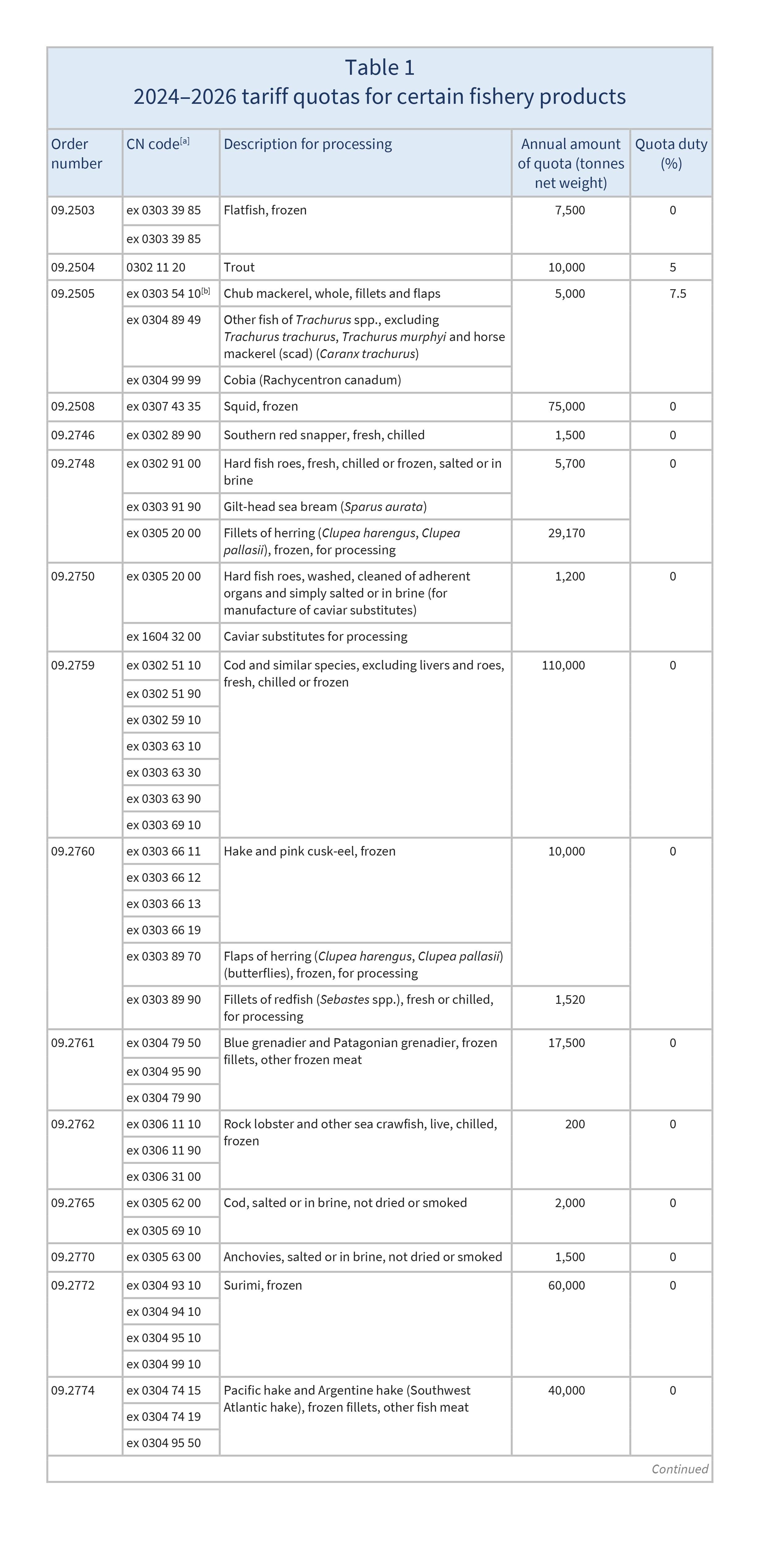Tariff quotas for certain fishery products
- Tariffs & quotas
Summary
The European Commission has opened new tariff quotas for fishery products for its processing industry, for the period 2024–2026.
EU opens new tariff quotas for fishery products for processing (2024–2026 period)
Council Regulation (EU) 2023/2720 of 27 November 2023 opening and providing for the management of the Union autonomous tariff quotas for certain fishery products for the 2024–2026 period
Update
The European Commission has opened new tariff quotas for fishery products for its processing industry, for the period 2024–2026.
Background
In recent decades, the EU has become increasingly dependent on imports of fish and fish products to meet demand. The EU’s fisheries and aquaculture production currently meets only 43% of its needs. The Union has concluded several agreements with non-EU countries or territories to permit the suspension or partial waiver of normal duties applicable to certain fishery products in order to ensure an adequate supply to its processing industry. These autonomous trade measures for fishery and aquaculture products enable the EU fish processing industry to import non-EU countries’ raw materials for further processing at reduced rates or duty-free, and allow Member States to draw from the tariff quota amount the quantities corresponding to their actual import needs.
Tariff quota entitlement is based on the supply of an appropriate volume, until the tariff quotas have been used up, and requires a minimum capacity of treatment or operation. Imports are subject to end-use customs supervision in accordance with Article 254 of Regulation (EU) 952/2013.
Impacted Products
Certain fish and fishery products destined for processing in the EU
What is changing?
The EU is suspending or reducing import duties on the fishery products listed in Table 1 for the period 2024–2026. These new tariff quotas are only for products that have undergone certain processing (e.g. dicing, filetting, production of flaps, cutting of frozen blocks). For full details of the individual quotas (detailed descriptions, TARIC customs codes), see the Annex of Regulation 2023/2720.
Why?
Autonomous tariff quotas (unlike quotas agreed through tariff negotiations) are unilaterally established by the EU in response to the needs of the EU fish processing industry, to avoid a shortfall in supplies of raw materials for processing.
Timeline
The Regulation applies from 1 January 2024.
The new quotas are valid until 31 December 2026.
What are the major implications for exporting countries?
The reduction or suspension of import duties for certain fishery products that the EU currently imports from non-EU countries provides opportunities for AGRINFO partners to export these species.
Recommended Actions
To find out how much quota has already been used for a specific product, visit the European Commission’s Tariff quota consultation webpage and enter the Order number (shown on the left of Table 1 below) without the decimal point: e.g. 09.2503 should be entered as 092503.
Resources
European Commission Tariff quota consultation
Sources
Regulation (EU) 2023/2720 opening and providing for the management of the Union autonomous tariff quotas for certain fishery products for the 2024–2026 period
Tables & Figures
Disclaimer: Under no circumstances shall COLEAD be liable for any loss, damage, liability or expense incurred or suffered that is claimed to have resulted from the use of information available on this website or any link to external sites. The use of the website is at the user’s sole risk and responsibility. This information platform was created and maintained with the financial support of the European Union. Its contents do not, however, reflect the views of the European Union.
EU opens new tariff quotas for fishery products for processing (2024–2026 period)
Regulation (EU) 2023/2720 opening and providing for the management of the Union autonomous tariff quotas for certain fishery products for the 2024–2026 period
What is changing and why?
For the period 2024–2026, the EU is suspending or reducing its import duties for certain fishery products that have undergone processing (e.g. dicing, filetting, production of flaps, cutting of frozen blocks). The EU unilaterally establishes ‘autonomous’ tariff quotas for these products in order to respond to the needs of the EU fish processing industry, and to avoid a shortfall in supplies of raw materials for processing.
Timeline
The Regulation applies from 1 January 2024.
The new quotas are valid until 31 December 2026.
Tables & Figures
Disclaimer: Under no circumstances shall COLEAD be liable for any loss, damage, liability or expense incurred or suffered that is claimed to have resulted from the use of information available on this website or any link to external sites. The use of the website is at the user’s sole risk and responsibility. This information platform was created and maintained with the financial support of the European Union. Its contents do not, however, reflect the views of the European Union.


